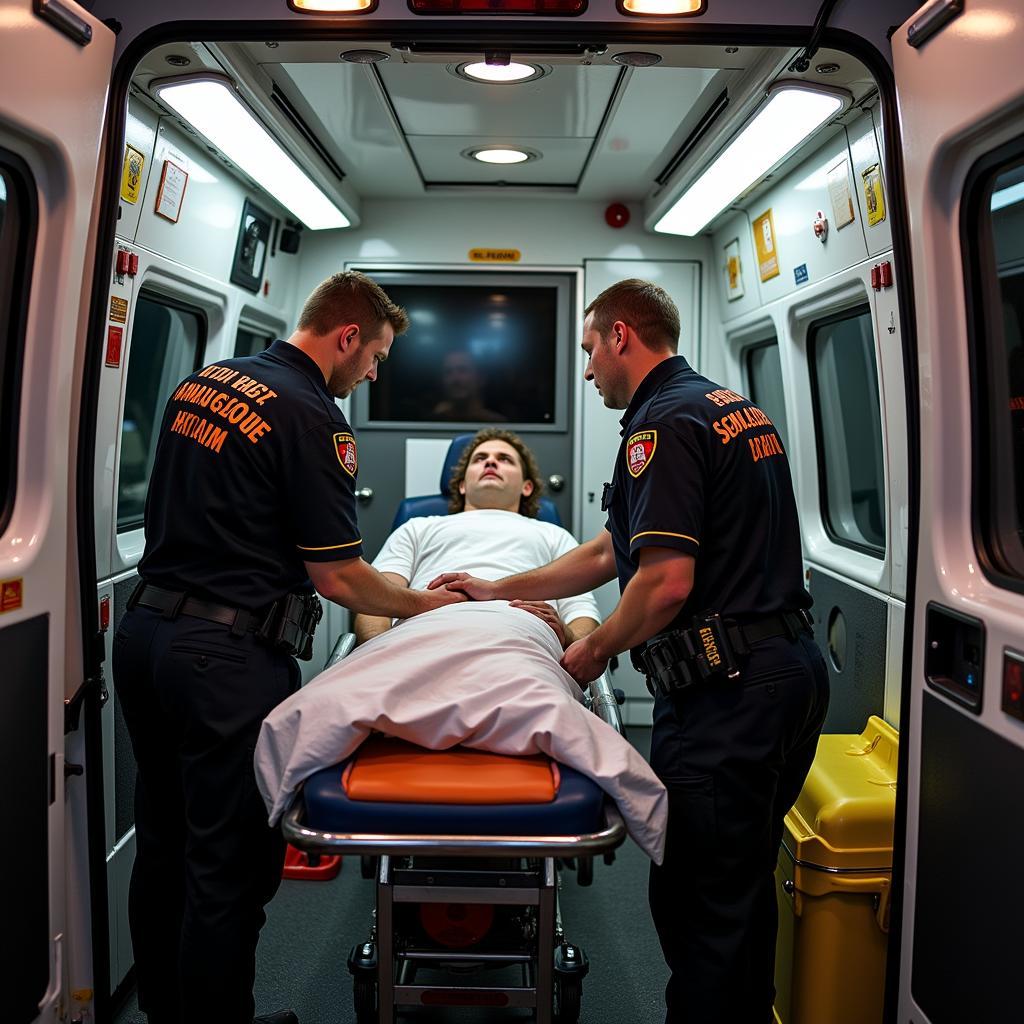Pre-hospital trauma life support (PHTLS) encompasses the crucial medical care given to trauma victims before they reach a hospital. It’s a coordinated effort by trained medical professionals to stabilize the patient’s condition and improve their chances of survival. From the moment an accident occurs to the arrival at the emergency room, every second counts.
 Paramedics providing pre-hospital trauma life support in an ambulance
Paramedics providing pre-hospital trauma life support in an ambulance
What is Pre-Hospital Trauma Life Support?
PHTLS involves a systematic approach to assess the severity of injuries, identify life-threatening conditions, and provide immediate medical intervention. This might include controlling bleeding, ensuring an open airway, stabilizing the spine, and administering fluids or medications.
The goal of PHTLS is not to provide definitive treatment but to buy time and ensure the patient arrives at the hospital in the best possible condition for further care.
The Importance of a Rapid Response
Time is of the essence in trauma cases. Delays in receiving appropriate medical care can significantly impact the outcome. PHTLS emphasizes a rapid response system that includes:
- Early activation of emergency medical services (EMS): Immediate notification of EMS allows for a prompt dispatch of paramedics and ambulances to the scene.
- Rapid assessment and triage: Upon arrival, paramedics quickly assess the situation, prioritize patients based on injury severity, and initiate life-saving interventions.
- Efficient transport to the appropriate facility: This might involve taking the patient to the nearest hospital or a specialized trauma center equipped to handle complex injuries.
Key Elements of Pre-Hospital Trauma Life Support
PHTLS protocols are constantly evolving based on the latest medical research and evidence-based practices. However, some core elements remain consistent:
- Airway management: Ensuring a clear and open airway is paramount. This may involve techniques like head-tilt chin-lift, suctioning, or advanced airway interventions.
- Breathing and ventilation: Assessing and managing breathing problems, including providing supplemental oxygen or assisting ventilation if needed.
- Circulation and hemorrhage control: Controlling bleeding is crucial to prevent hypovolemic shock. This can be achieved through direct pressure, wound packing, or tourniquet application.
- Disability (neurological assessment): Evaluating the patient’s level of consciousness and neurological function to identify potential head or spinal injuries.
- Exposure and environmental control: Exposing the patient to assess injuries while preventing hypothermia by using blankets or warming techniques.
Specialized Training for Pre-Hospital Professionals
Paramedics, emergency medical technicians (EMTs), and other pre-hospital care providers receive specialized training in PHTLS. This training equips them with the knowledge and skills to:
- Rapidly assess and manage trauma patients.
- Perform life-saving interventions effectively.
- Make critical decisions under pressure.
- Communicate and coordinate care seamlessly with hospital teams.
The Impact of PHTLS on Trauma Outcomes
The implementation of effective PHTLS systems has been shown to significantly improve outcomes for trauma patients. By providing immediate and appropriate care at the scene, PHTLS helps to:
- Reduce mortality rates from severe injuries.
- Minimize the severity of disabilities.
- Improve the chances of a full recovery.
Pre-Hospital Trauma Life Support at [Hospital Name]
At [Hospital Name], we recognize the critical role of pre-hospital care in trauma management. Our emergency department works closely with local EMS agencies to ensure a seamless transition of care for trauma patients. We are committed to providing the highest level of emergency medical services, 24 hours a day, 7 days a week.
For information on Fuda Cancer Hospital China, you can visit our website.
FAQs about Pre-Hospital Trauma Life Support
What should I do if I witness an accident?
Immediately call emergency services (911) and provide accurate information about the location and nature of the incident. If it’s safe to do so, provide basic first aid until help arrives.
What is the Golden Hour in trauma care?
The Golden Hour refers to the first hour after a traumatic injury. During this time, prompt medical intervention has the highest likelihood of preventing death or disability.
When should I call 911 for a medical emergency?
Always err on the side of caution. If you suspect someone is experiencing a life-threatening condition, such as difficulty breathing, chest pain, severe bleeding, or a sudden change in consciousness, call 911 immediately.
What is a trauma center?
Trauma centers are hospitals equipped and staffed to handle severe and complex injuries. They have dedicated trauma teams, specialized operating rooms, and advanced imaging capabilities.
How can I learn more about first aid and CPR?
Several organizations offer first aid and CPR training courses, including the American Red Cross, the American Heart Association, and local community centers.
If you have concerns about FIR Unit Hospital, please consult our website for detailed information.
Need Immediate Medical Assistance?
For urgent medical concerns, please contact us at 02437655121 or email us at [email protected]. Our dedicated team at [Hospital Name], located at Số 298 Đ. Cầu Diễn, Minh Khai, Bắc Từ Liêm, Hà Nội, Việt Nam, is available 24/7 to provide compassionate and comprehensive care.